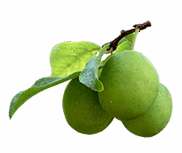|
|
|
| |
| Endemic plums is purely wild plums with 10000
or longer history in Korea peninsula. They are very
strong botanically and the principal element, citric
acid is more superior than contained in improved
breeds of plums.
The time plums become ripe enough is generally near
the middle or last days of June. Even though plums
are ripe, it is easy to break tooth if taking as
raw plums. In addition ripe plums cannot be stored
for long time despite refrigerating or freezing
processes like bananas.
|
 |
Thus our ancestors have used plums
as a kind of medical elements by salting to make
Baekmae and smoking to make Omae (From Dongeuibogam).
Nowadays scientific ways to process ripe plums and
preserve citric acids are developed well. This introduces
how to process plums to make alcoholic drinks, Jangajji
(dried and/or seasoned foods), and undiluted solution
of plums. |
|
 |
 |
| Soju Solution |
¨ç Prepare 10kg of plums and
10 bottles of 1.8L Soju (25Do). Soak plums in Soju
in a
¨ç Korean jar and cover
with Korean traditional window?paper. Store it in
the shade.
¨è After 3 months (near Chubun ? September 22), filter
the soaked drinks. For 1L of
¨è filtered drink, dilute
with 2~3L of 25Do Soju.
¨é According to the tastes, add brown sugar. Store
drinks in a glass bottle under
¨é the shade. The longer
the drink matures, the better the drinks tastes.
¨é Clear brown colored
drink has a very nice scent and taste. |
|
| Sugar solution |
¨ç Mix 10kg of plums and 5kg
of brown sugars in a Korean jar. Cover with brown
¨ç sugar. With a plate,
cover the jar and seal the jar with the vinyl.
¨è Brew for 3~4 weeks in the shade. On a clear day
between Chobok (July 17) and
¨ç Jungbok (July 27),
filter the brewed drinks.
¨é For 1L of filtered drink, dilute with 2~2.5L.
Store in the same way with the Soju
¨ç solution. |
|
 |
 |
¨ç Mix 10kg of plums with 1~1.5kg
of sun?dried salt and put it in a Korean jar.
¨è Cover the mixture with salts. Close the jar with
inner lid put some stones to press.
¨ç Seal the jar with
the vinyl.
¨é After ripening for 3~4 weeks in the shade, plums
would shrink and clear and brown
¨ç water would be generated.
If using a glass jar, the ripening process would
be seen.
¨ç The water is Baekmaecho
and shrunk plums are Baekjangajji.
¡Ø Baekmaecho is very good for health and it can
be used as a salty condiment. |
|
 |
 |
¡ØTo make Hongmaecho/Hongjangajji,
Chajogi (a.k.a. Chamsoyeop ? purple perilla plant)
should be added to Baekmaecho/Baekjangajji. 3kg
of Chamsoyeop leaves is needed for 10kg of plums.
¨ç Soak Chamsoyeop in 1/10 salty water for 1~2 hours.
Soaked water is needless.
¨è Scrub salted Chamsoyeop leaves with salts for
10~20 minutes. Blackish brown
¨ç water is generated
and the leaves become fibrous.
¨é Pour blackish brown water into the Baekjangajji
jar and cover with fibrous leaves.
¨ç The water and plums
will be purple color by the litmus effect.
¨ê Leave the jar sealed for 3 days~3 weeks since
it is the rainy season.
¨ë After the season is over, dry the plums for 8~10
hours under the sun.
¨ç Take care of plums
not to stick together.
¨ì Put the dried plums into the jar again.
¨í Select some fine day and repeat the process of
5 and 6 for 3~4 times in order to
¨ç make the plums absorb
the color.
¨î On the last day, leave the plums for a clear night.
In the early morning, put the wet
¨ç plums with morning
dew into the jar. Seal and store the jar under the
shade for
¨ç ripening until the
middle of October. The plums would be the best Honghangajji
¨ç (Umeboshi in Japan)
¡ØNotes for making Honghangajji
¨ç Plums should be ripe enough and one side of the
fruit should be brown color.
¨è Sizes of the plums should be regular without any
scratches.
¨é The jar should be glass or ceramic jar.
¨ê If plums catch in a sudden shower, disinfect the
plums with Soju. Scratched plums
¨ç are like Honghangajji. |
|
 |
 |
¨ç 1. Steam the plums and dry
under the sun. Store it at the room temperature.
¨è 1. Boil down 1 or 2 plums a day. Upon the taste,
add sugar or honey. |
|
 |
| |
|
|
|
|
|